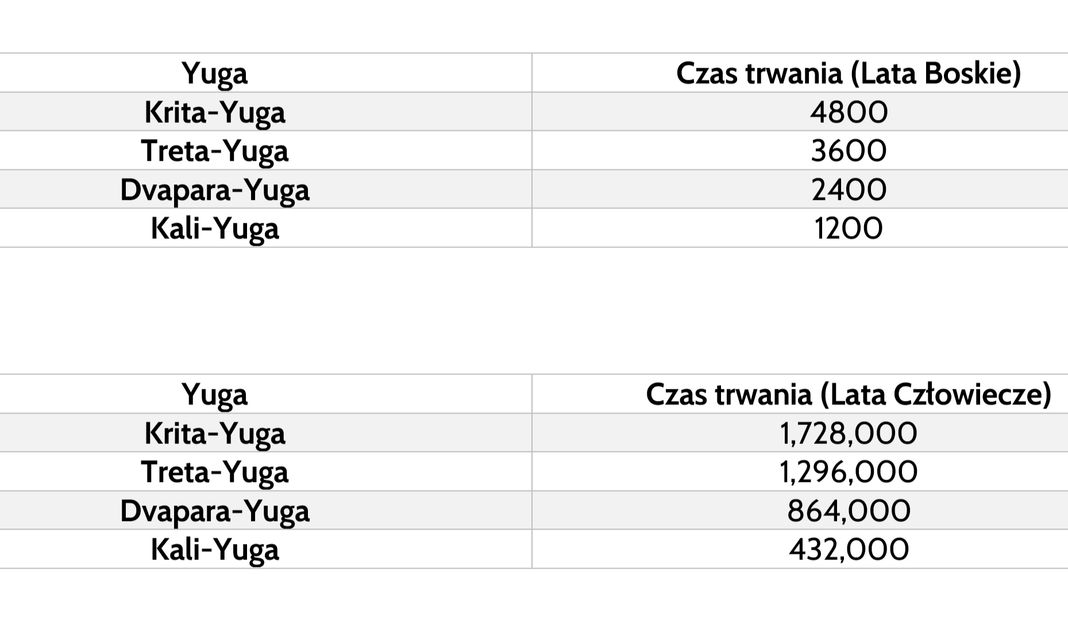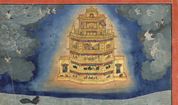Yugi – hinduskie cykle czasu

Yugi – hinduskie cykle czasu
Mahabharata:
Yudhisthira zauważa teraz, że Markandeya doświadczył w sposób wyjątkowy wielokrotnego rozpadu i ponownego stworzenia świata i prosi go o opisanie tego. - Markandeya zaczyna od oddania szacunku Krysznie, którego identyfikuje jako stwórcę wszystkiego. Dalej opisuje następstwo wieków. Wiek Krita trwa w sumie 4800 lat; po niej następuje z kolei Wiek Treta (3600 lat), Wiek Dvapara (2400 lat) i Wiek Kali (1200 lat), po których następuje nowy Wiek Krita. Tysiąc takich cyklów to jeden dzień Brahmy. Gdy każdy cykl zbliża się do końca, ludzie degenerują się, a natura zaczyna zawodzić; pod koniec tysięcznego cyklu, świat jest niszczony przez głód, ogień i powódź, aż nie pozostanie nic poza szalejącym oceanem.[1]
Wiek Krita trwa przez cztery tysiące lat bogów, ze świtem i zmierzchem po czterysta lat każdy; każdy z trzech kolejnych epok jest krótszy o tysiąc lat, a jego świt i zmierzch są krótsze o sto lat. W Wieku Krita, dharma [czyli czyny, które są prawe] jest kompletna, ale w każdym kolejnym wieku jest ona pomniejszana o jedną czwartą; w Wieku Krita nie ma choroby, a ludzie żyją czterysta lat, ale w każdym kolejnym wieku długość życia skraca się o jedną czwartą, tak jak wiedza o Wedach i korzyści, które z niej płyną. Najwyższą dharmą Wieku Krita jest asceza, w Wieku Treta jest to wiedza, Wieku Dvapara -ofiara, a w Wieku Kali - dawanie darów.[2]
- Anonymous, Smith D. John, The Mahābhārata: str. 200, tłumaczenie własne z języka angielskiego, tekst oryginalny:
Yudhisthira now remarks that Markandeya has, uniquely, experienced the repeated dissolution and re-creation of the world, and asks him to describe it. – Markandeya begins by reverencing Krishna whom he identifies as the creator of all. He then describes the succession of the ages. The Krita Age lasts for a total of 4,800 years; it is followed in turn by the Treta Age (3,600 years), the Dvapara Age (2,400 years) and the Kali Age (1,200 years), after which comes a new Krita Age. A thousand such cycles constitute one day of Brahmā. As each cycle nears its end men become degenerate and nature begins to fail; at the end of the thousandth cycle the world is devastated by famine, fire and flood, till nothing is left but a raging ocean. - Anonymous, Smith D. John, The Mahābhārata: str. 639, tłumaczenie własne z języka angielskiego, tekst oryginalny:
The Krita Age lasts for four thousands years of the gods, with a dawn and dusk of four hundred years each; each of the three succeeding ages is shorter by a thousand years, and its dawn and dusk are both shorter by a hundred years. In the Krita Age, dharma is complete, but in each succeeding age it is diminished by a quarter; in the Krita Age there is no disease and men live for four hundred years, but in each succeeding age the span of life is reduced by a quarter, as if knowledge of the Veda and the benefit it brings. The paramount dharma of the Krita Age is asceticism, of the Treta Age it is knowledge, of the Dvapara Age sacrifice, and of the Kali Age the giving of gifts.





Trwa ładowanie...